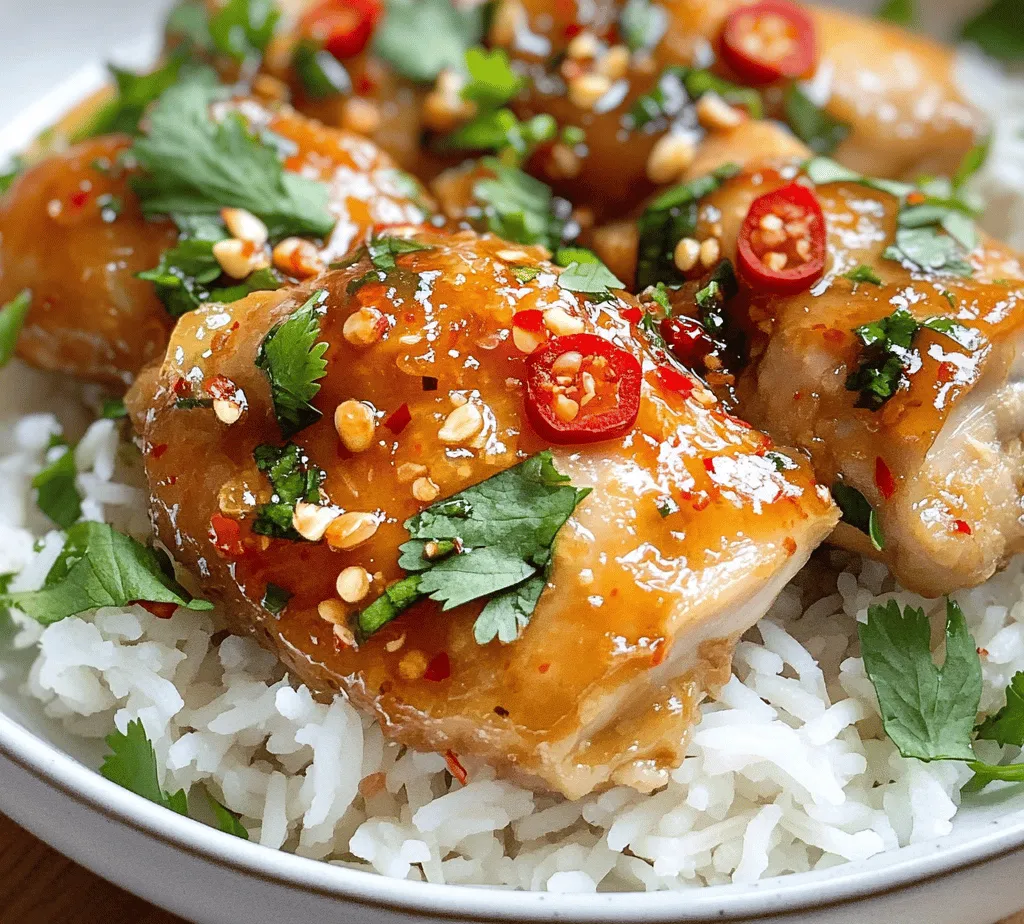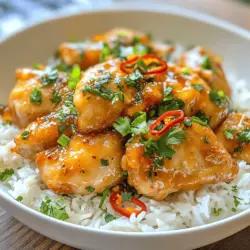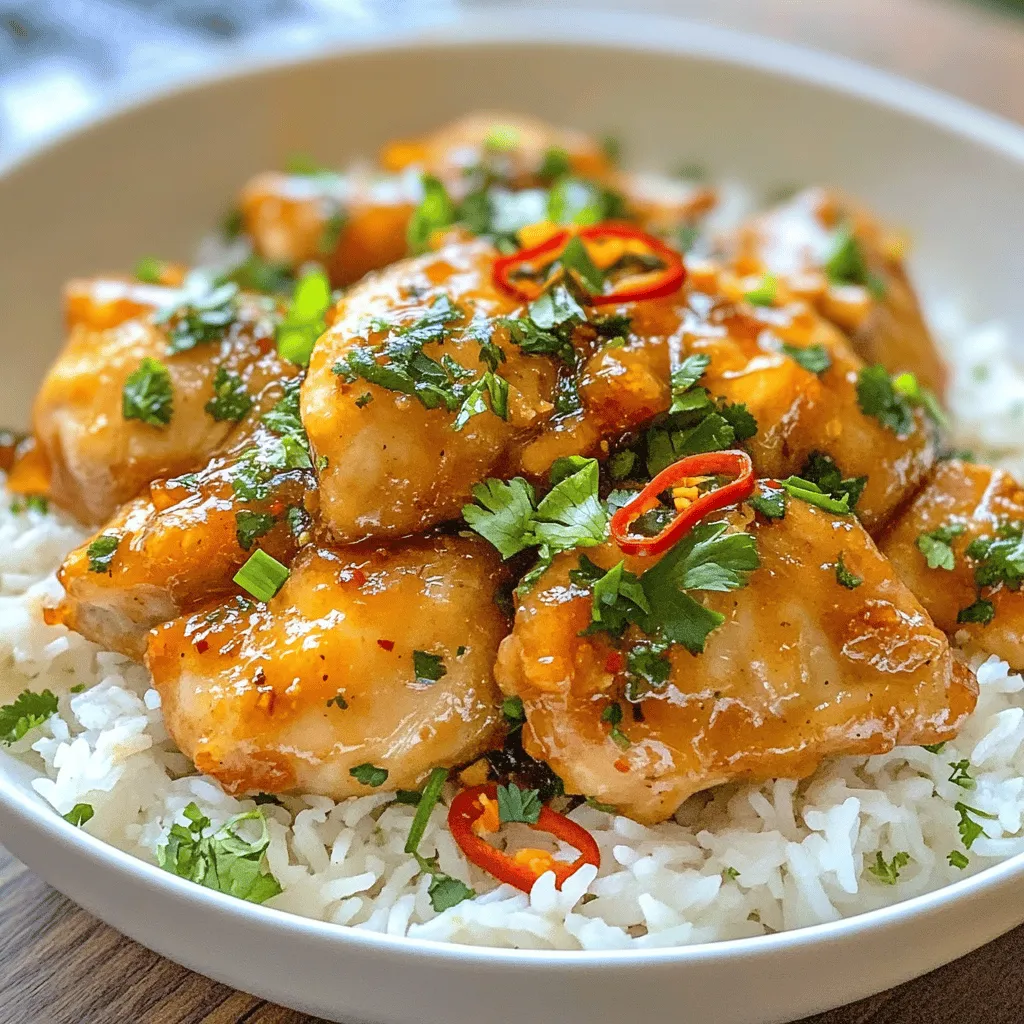Introduction
Vietnamese cuisine is celebrated worldwide for its vibrant flavors, fresh ingredients, and harmonious balance of taste. Each dish tells a story through its ingredients, which often include a delightful mix of sweet, sour, salty, and umami flavors. One such dish that embodies this culinary philosophy is Vietnamese Caramel Ginger Chicken, a beloved staple in many Vietnamese households. This dish is not just a meal; it’s a comforting reminder of home, often enjoyed during family gatherings and special occasions.
Caramel Ginger Chicken stands out for its unique ability to balance sweetness and savory, creating a rich, mouthwatering experience. The dish features tender chicken thighs simmered in a luscious caramel sauce, infused with the aromatic notes of ginger and garlic. This combination of flavors makes it a favorite among both locals and those who are fortunate enough to experience Vietnamese cuisine.
In this article, we will explore how to recreate this authentic Vietnamese dish in your own kitchen, starting with a closer look at the ingredients that make this recipe so special.
Understanding the Ingredients
To create the perfect Vietnamese Caramel Ginger Chicken, it is essential to understand the role of each ingredient in the recipe. Here is a detailed breakdown:
Chicken Thighs
For this recipe, chicken thighs are the preferred choice over chicken breasts for several reasons. First, chicken thighs are more flavorful and juicy, making them ideal for braising and simmering in sauces. Their higher fat content ensures that they remain moist and tender, even after prolonged cooking. Additionally, chicken thighs absorb flavors more effectively than breasts, allowing the marinade and sauce to penetrate deeply, enhancing the overall taste of the dish.
Fish Sauce
A staple in Vietnamese cooking, fish sauce is a fermented condiment made from anchovies and salt. It provides a distinctive umami flavor that is crucial in balancing the sweetness of the caramel sauce with a savory depth. Fish sauce is not just an ingredient; it is the essence of Vietnamese cuisine, adding complexity and richness to various dishes. When used in this recipe, it helps to elevate the flavors of the chicken, ensuring that each bite is packed with a robust taste.
Fresh Ginger and Garlic
Fresh ginger and garlic are essential aromatics in this recipe, contributing to its fragrant profile. Ginger adds a warm, spicy note that complements the sweetness of the caramel, while garlic provides a savory depth. Together, these two ingredients create a fragrant base that enhances the overall flavor of the dish. For the best results, it is recommended to use fresh ginger and garlic rather than powdered versions, as they offer a more vibrant and pungent flavor.
Sugar
Sugar plays a pivotal role in creating the caramel sauce that defines this dish. When heated, sugar undergoes a transformation, turning from granules into a smooth, amber liquid that adds sweetness and a complex flavor to the dish. The caramelization process not only gives the sauce its rich color but also balances the savory elements of the chicken and fish sauce. It’s essential to manage the sugar carefully during this stage, as overcooking can lead to bitterness.
Soy Sauce, Rice Vinegar, and Oyster Sauce
In addition to the primary ingredients, soy sauce, rice vinegar, and oyster sauce further enhance the flavor profile of Vietnamese Caramel Ginger Chicken. Soy sauce adds saltiness and depth, while oyster sauce introduces a touch of sweetness and umami. Rice vinegar contributes a subtle acidity, balancing the overall flavors and cutting through the richness of the dish. Together, these ingredients work in harmony to create a well-rounded, flavorful sauce that envelops the chicken.
Marination: The Key to Flavor
Marinating the chicken is a crucial step that helps infuse it with flavors and tenderizes the meat. In this recipe, the chicken is marinated in a mixture of fish sauce, soy sauce, and a touch of sugar. This combination allows the chicken to absorb the salty, umami-rich flavors while also developing a slight sweetness.
Significance of Marinating
Marination not only enhances the flavor profile but also acts to tenderize the chicken. The enzymatic action from the acids in the marinade breaks down proteins in the meat, leading to a more succulent texture. For optimal flavor, it is recommended to marinate the chicken for at least 30 minutes, but for even better results, marinating it overnight in the refrigerator is ideal. This extended time allows the flavors to penetrate deeply, ensuring that each bite is bursting with taste.
Suggested Marinating Techniques
To marinate effectively, place the chicken thighs in a resealable plastic bag or a shallow dish. Pour in the marinade and ensure that the chicken is evenly coated. If using a bag, press out the air and seal it tightly to allow the marinade to envelop the chicken completely. If using a dish, cover it with plastic wrap to prevent any contamination. Remember to refrigerate while marinating, and turn the chicken occasionally to promote even flavor distribution.
Creating the Perfect Caramel Sauce
The caramel sauce is the star of the show in this Vietnamese Caramel Ginger Chicken recipe. Achieving the right consistency and flavor requires attention to detail, particularly when it comes to temperature control.
Steps to Make Caramel Sauce
To begin the process of making the caramel sauce, you will need sugar and water. Start by combining equal parts sugar and water in a heavy-bottomed saucepan over medium heat. As the mixture heats, stir gently until the sugar dissolves completely. Once dissolved, stop stirring and allow the mixture to come to a boil.
Importance of Temperature Control
Temperature control is vital when making caramel. If the heat is too high, the sugar can burn quickly, leading to a bitter taste. It’s crucial to keep a close eye on the heating process. As the mixture boils, it will gradually change color. At this stage, you are aiming for a golden amber hue, which indicates that the caramel is ready.
Tips for Achieving the Right Amber Color
To achieve the perfect amber color without burning the sugar, watch the mixture closely as it cooks. Swirl the pan gently to encourage even cooking, but avoid stirring, as this can cause the sugar to crystallize. When the desired color is reached, promptly remove the pan from the heat.
Managing the Bubbling Reaction
When you add oil or any liquid to the caramel, it will bubble vigorously. This reaction is natural and occurs due to the sudden temperature change. To manage this, add the oil slowly and carefully, allowing the bubbling to subside before proceeding with additional ingredients. This will help prevent any splattering and ensure a smooth integration of the flavors.
Cooking Process: Bringing It All Together
Once the chicken is marinated and the caramel sauce is prepared, it’s time to bring all the elements together for a delicious Vietnamese Caramel Ginger Chicken experience.
In the next part of this article, we will delve into the actual cooking process, including how to combine the marinated chicken with the caramel sauce and other ingredients to create a dish that is not only flavorful but visually stunning as well. Stay tuned to discover the final steps that will transform your kitchen into a Vietnamese culinary haven!

Detailed Step-by-Step Instructions
Sautéing Garlic and Ginger
To kick off the preparation of your Vietnamese Caramel Ginger Chicken, the first step involves sautéing garlic and ginger. Timing is crucial here, as both ingredients release their flavors at different rates. Begin by heating a tablespoon of vegetable oil in a large skillet or wok over medium heat. Once the oil is shimmering, add a generous amount of minced garlic and ginger.
Sauté the garlic until it turns golden brown, which should take about 1-2 minutes. Be careful not to burn it, as burnt garlic can impart a bitter taste to your dish. Next, add the freshly minced ginger. The goal is to infuse the oil with the aromatic flavors of both ingredients. Stir continuously for about another minute until the ginger softens and its fragrance fills the kitchen. This step is essential as it lays a flavorful foundation for your chicken.
Incorporating Marinated Chicken into the Caramel Sauce
Once your garlic and ginger are perfectly sautéed, it’s time to introduce the star of the dish: the marinated chicken. Carefully add the chicken pieces to the skillet, ensuring they are well-coated with the oil, garlic, and ginger mixture. You should hear a satisfying sizzle as the chicken hits the pan.
Cook the chicken for about 5-7 minutes, stirring occasionally. This helps the chicken to develop a nice sear, which enhances the overall flavor. Once the chicken is browned on all sides, it’s time to add the caramel sauce. Pour the pre-prepared caramel sauce over the chicken, ensuring each piece is generously coated. The caramel will start to bubble, creating a rich glaze that will cling to the chicken as it cooks.
Techniques for Simmering the Chicken to Retain Moisture and Tenderness
After adding the caramel sauce, reduce the heat to low and cover the skillet with a lid. This will allow the chicken to simmer gently, absorbing all the delicious flavors from the caramel sauce. Simmering is crucial for maintaining the chicken’s moisture and tenderness; this process will take about 15-20 minutes.
Check the chicken periodically, stirring to ensure even cooking. If the sauce becomes too thick, add a splash of water or chicken broth to maintain a good consistency. The chicken is done when it reaches an internal temperature of 165°F (75°C) and is tender to the bite. The result should be succulent pieces of chicken enveloped in a glossy, sweet, and savory caramel sauce.
Flavor Enhancements: Spice and Seasoning
Discussion on the Addition of Oyster Sauce and Red Chilies
To elevate the flavors of your Vietnamese Caramel Ginger Chicken, consider the addition of oyster sauce and fresh red chilies. Oyster sauce introduces a savory umami depth that complements the sweetness of the caramel. It’s a staple in Vietnamese cooking and enhances the overall taste profile of the dish.
To include oyster sauce, simply add 1-2 tablespoons during the last few minutes of cooking, stirring well to combine. Fresh red chilies not only add a vibrant pop of color to your dish but also introduce a spicy kick. You can slice them thinly and toss them in during the simmering stage for a subtle heat or add them as a garnish before serving for a bolder flavor.
Adjusting Spice Levels According to Personal Preferences
The beauty of cooking is that you can tailor recipes to suit your taste. If you prefer a milder dish, you may opt to omit the chilies entirely, or you could use a milder variety, such as bell peppers. Conversely, if you enjoy spicy food, feel free to increase the number of chilies or even add a dash of chili flakes to the caramel sauce for an extra punch. Remember, tasting as you cook is key to achieving the perfect balance of flavors.
Serving Suggestions
Best Practices for Serving Vietnamese Caramel Ginger Chicken
Once your Vietnamese Caramel Ginger Chicken is ready, it’s time to think about presentation and serving. This dish is best served hot and fresh from the stove. Using a large serving bowl, carefully transfer the chicken, ensuring that you drizzle any remaining caramel sauce over the top. The glossy finish will not only make it visually appealing but will also enhance the flavor with every bite.
Pairing Options: Steamed Jasmine Rice and Other Vegetable Sides
Vietnamese Caramel Ginger Chicken pairs beautifully with steamed jasmine rice, as the fluffy grains soak up the luscious caramel sauce. For a complete meal, consider adding a side of sautéed vegetables, such as bok choy, broccoli, or green beans. These vibrant greens not only provide a nutritional balance but also add a splash of color to your plate.
If you’re looking to add a traditional touch, serve the dish with a side of pickled vegetables, which can help cut through the richness of the caramel sauce, providing a refreshing contrast.
Presentation Tips to Enhance the Dining Experience
When serving your dish, consider garnishing it with freshly chopped cilantro or green onions for an added layer of freshness. You can also sprinkle sesame seeds on top for a nutty crunch. Serve in colorful bowls or plates to highlight the dish’s vibrant colors, making your meal not only delicious but also visually enticing.
Nutritional Information
Overview of Nutrition Facts for a Serving of Vietnamese Caramel Ginger Chicken
A single serving of Vietnamese Caramel Ginger Chicken typically contains approximately 350-400 calories, depending on the portion size and specific ingredients used. This dish is relatively balanced, providing a good source of protein from the chicken and essential vitamins from garlic and ginger.
Discussion of Health Benefits of Key Ingredients
Ginger, a key ingredient in this dish, is well-known for its anti-inflammatory and antioxidant properties. It can aid digestion and may even help to reduce nausea. Garlic is also a powerhouse of health benefits; it’s known to boost the immune system, reduce blood pressure, and improve cholesterol levels. Together, these ingredients not only enhance flavor but also contribute to your overall well-being.
Storing and Reheating
Best Methods for Storing Leftovers to Maintain Flavor and Texture
If you have leftovers of your Vietnamese Caramel Ginger Chicken, store them in an airtight container in the refrigerator. To maintain the quality and flavor, consume the leftovers within 3-4 days. For longer storage, consider freezing the chicken in a freezer-safe container. When properly stored, it can last up to three months in the freezer.
Tips for Reheating the Dish Without Losing Quality
When reheating, be mindful to do so gently to preserve the chicken’s moisture. The best method is to reheat in a skillet over low heat, adding a splash of water or broth to help steam the chicken and keep it from drying out. Stir occasionally until heated through. If using a microwave, cover the container with a damp paper towel to retain moisture and heat in short intervals, stirring in between.
Conclusion
Vietnamese Caramel Ginger Chicken is not just a meal; it’s an experience that encapsulates the vibrant flavors and culinary traditions of Vietnam. The intricate balance of sweet, savory, and spicy elements makes this dish a standout that is sure to impress family and friends alike. With its rich history and cultural significance, exploring this recipe allows you to connect with Vietnamese cuisine on a deeper level.
We invite you to delve into more Vietnamese recipes and culinary traditions that celebrate the country’s rich flavors and diverse ingredients. Whether you’re a seasoned cook or just starting your culinary journey, there’s always something new to explore in the world of Vietnamese cooking. Enjoy your culinary adventure, and savor every bite of your delicious Caramel Ginger Chicken!


